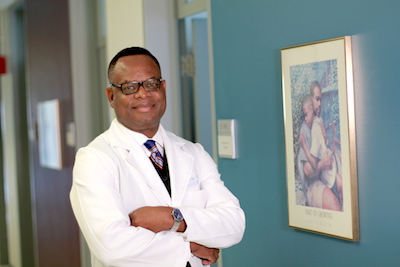 |
|
| Benjamin Nwosu, MD |
Benjamin U. Nwosu, MD, has developed a valuable new tool in the battle against type 1 diabetes, according to a study published May 1 by PLOS ONE.
The tool enables clinicians to predict whether children with newly diagnosed type 1 diabetes will experience temporary, but beneficial, partial clinical remission during their early months in treatment. Patients who are unlikely to enter the so-called “honeymoon phase” can then be closely monitored and treated appropriately to help avoid long-term complications associated with nonremission.
“Our paper is the first to come up with a predictive model for nonremission,” said Dr. Nwosu, associate professor of pediatrics. “This presents the opportunity for clinicians to identify patients who are unlikely to remit, and then begin to ensure a normal or close to normal glucose profile in the first months of treatment of type 1 diabetes.”
The study integrated simple and easily accessible clinical markers of nonremission and validated them against the gold-standard definition of partial clinical remission, which is an insulin-dose adjusted hemoglobin A1c level of 9 or less. Recent research has established that this measure confirms that patients have entered the honeymoon phase, in which they are able to make some of their own insulin and their blood glucose levels are restored to at or near normal levels for a period lasting from three months to a year after treatment begins.
Prior to this definitive measure, it had been incorrectly assumed that all patients with newly diagnosed type 1 diabetes experienced partial clinical remission.
“Using this gold-standard definition, we found that 57 percent of our patients did not have a honeymoon phase,” said Nwosu. “That means half the population of children and adolescents diagnosed with type 1 diabetes are destined for poor outcomes with long-term complications.”
Previous research has confirmed that individuals who do not experience partial clinical remission require higher doses of insulin over the long term and are more likely to suffer from serious diabetes-related complications including blindness and cardiovascular problems later in life.
“In the past, endocrinologists let patients run high on their blood sugar levels in the early course of the disease on the assumption that every patient was going through the honeymoon phase and that there was no need to tighten blood sugar control in any particular subset of patients,” said Nwosu. “But now we know that those who will not enter the honeymoon phase at diagnosis will require an initial tighter blood sugar control to prevent the early phase of hyperglycemia that sets them up for increased risk for long-term complications decades later.”
The predictive model developed and verified by Nwosu and colleagues in the Diabetes Center of Excellence at UMMS comprises several metrics that have previously been shown to be associated with nonremission: blood bicarbonate of less than 15 mg/dL; age 5 years or younger; female gender; and the presence of three or more diabetes-associated autoantibodies.
The model predicts with 73 percent accuracy which patients are unlikely to experience the honeymoon phase. Nwosu anticipates that future studies will fine-tune the initial findings with more determinants of nonremission to increase its power of prediction.
Related stories on UMassMedNow:
UMMS study finds majority of children with irritable bowel syndrome are low on vitamin D
MedPage Today: Nwosu explains link between type 2 diabetes in children and liver disease